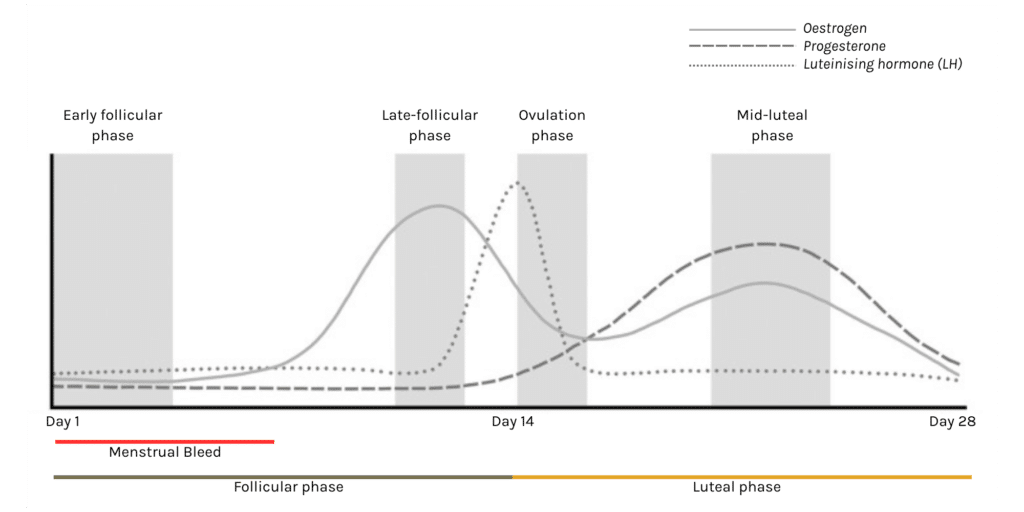If you’ve been struggling with irregular periods, PMS symptoms, or simply want to understand how to balance hormones through nutrition, you’re not alone. The relationship between what we eat and our hormonal health is more complex—and more fascinating—than many of us realise.
As a registered dietitian specialising in women’s health, I’ve witnessed firsthand how understanding your menstrual cycle can transform your relationship with food and your body. However, the reality is that women have been underrepresented in health research for decades, particularly regarding menstrual cycle studies. This gap means much of what we know about nutrition and hormones requires a nuanced, individualised approach rather than one-size-fits-all solutions.
Understanding Your Menstrual Cycle: The Foundation of Hormonal Health
Before diving into the best diet for hormones, it’s essential to understand what’s actually happening in your body each month. While many people think of the menstrual cycle as having just two phases, there are actually four distinct hormonal phases that influence everything from your appetite to your energy levels.

The Four Phases of Your Cycle
Early Follicular Phase (Days 1-5): During menstruation, oestrogen, progesterone, and luteinising hormone (LH) levels remain low. This is when your body is shedding the uterine lining and preparing for a fresh start.
Late Follicular Phase (Pre-ovulation): Oestrogen rises dramatically—higher than in any other phase—while progesterone stays low and LH begins to climb. This is often when many women feel their most energetic.
Ovulatory Phase (24-36 hours): LH peaks and triggers ovulation, while oestrogen remains elevated but begins to decline. Progesterone starts its gentle rise.
Mid-Luteal Phase (7 days post-ovulation): Both oestrogen and progesterone reach significant levels, with progesterone dominating. This is when many women experience PMS symptoms if hormones aren’t well-balanced.
How Your Cycle Affects Your Appetite: The Science Behind Your Cravings
Understanding these hormonal fluctuations explains so much about why your relationship with food changes throughout the month. Research reveals several key patterns:
Oestrogen acts as a natural appetite suppressant, which explains why you might feel less hungry around ovulation when oestrogen peaks.
Progesterone, particularly in the presence of oestrogen, increases appetite. This is why you likely notice stronger cravings and increased hunger during your luteal phase.
Studies show that women consume approximately 159-529 calories more per day during the mid-luteal phase compared to the early follicular phase. Additionally, the luteal phase promotes greater glycogen storage during rest and enhanced fat burning during exercise—your body is literally preparing for the possibility of pregnancy.
Interestingly, adequate nutrition is essential for hormonal production, with nutrients serving as cofactors and regulators in the synthesis of reproductive hormones like oestrogen and progesterone.
The Truth About Menstrual Cycle Syncing
Now, let’s address the elephant in the room: cycle syncing. You’ve probably seen countless social media posts claiming you need specific vitamins only during certain phases, or that you must eat particular foods at exact times in your cycle.
Here’s what the science actually tells us: there’s very limited evidence supporting rigid cycle syncing protocols. Why? Because every woman’s hormonal fluctuations differ both between individuals and from one cycle to another.
Third Sister Tips: A Realistic Approach to Cycle Awareness
Instead of following strict cycle syncing rules, I recommend cycle awareness—understanding your patterns and responding compassionately to your body’s changing needs:
Prepare for Mid-Luteal Cravings: Stock your kitchen with nutrient-dense snacks like nuts, seeds, and fruit when you know increased appetite is coming. This isn’t about restriction—it’s about preparation.
Prioritise Nutrient Density During Ovulation: When your appetite naturally decreases around ovulation, focus on making every bite count with foods rich in vitamins, minerals, and antioxidants.
Support Your Body During Bleeding: Emphasise iron-rich foods during menstruation to replenish stores and combat fatigue. Think lean red meat, lentils, and dark leafy greens.
Building Your Personalised Diet for Hormones
Rather than following restrictive cycle syncing protocols, focus on foundational nutrition principles that support overall hormonal health. Research shows that exercising regularly and eating a nutritious diet rich in protein and fiber can help naturally balance hormones.
The Hormone-Supporting Plate
Quality Protein (25-30% of your plate): Protein provides the amino acids necessary for hormone production. Healthy fats serve as building blocks for hormone synthesis and are crucial for the proper production of steroid hormones like oestrogen and progesterone. Include sources like:
- Fish (salmon, sardines)
- Pasture-raised eggs
- Legumes and beans
- Organic poultry
Healthy Fats (20-25% of your plate): Essential for hormone production and reducing inflammation:
- Avocados
- Extra virgin olive oil
- Nuts and seeds (particularly flaxseeds and chia seeds)
- Fatty fish
Complex Carbohydrates (40-45% of your plate): Wholegrain carbohydrates provide essential B vitamins which support hormone balance and healthy elimination of spent hormones. Choose:
- Quinoa and brown rice
- Sweet potatoes
- Oats
- Vegetables and fruits
Fibre-Rich Foods: Aim for 25-35g daily to support hormone detoxification through healthy elimination. Focus on vegetables, fruits, legumes, and whole grains.
What to Limit for Better Hormonal Health
Certain foods and lifestyle factors can disrupt hormonal balance:
Highly Processed Foods: These often contain additives and preservatives that may interfere with hormone production and metabolism.
Excess Sugar: Spikes in blood sugar can affect insulin, which influences other hormones throughout your body.
Alcohol: While moderate consumption may be fine for some, alcohol can impact liver function and hormone metabolism.
Environmental Toxins: Choose organic when possible for the “Dirty Dozen” foods, and consider filtering your water to reduce exposure to hormone-disrupting chemicals.
The Individual Approach: Why One Size Doesn’t Fit All
Here’s what I wish every woman knew: your menstrual cycle is as unique as you are. Some women experience dramatic appetite changes, while others notice subtle shifts. Some have 28-day cycles, others have 35-day cycles—and both can be perfectly healthy.
Research limitations make it challenging to create universal recommendations. Studies often use different methods to track cycle phases, examine single meals in artificial settings, and don’t account for the significant individual variation between women.
Third Sister Tips: Listen to Your Body
Rather than fighting against your natural rhythms, try:
Track Your Patterns: Use a simple app or journal to notice how your appetite, energy, and cravings change throughout your cycle.
Honour Your Hunger: If you’re genuinely hungrier during your luteal phase, eat more. Your body is working harder during this time.
Focus on Consistency: Aim for regular, balanced meals that include protein, healthy fats, and complex carbohydrates regardless of where you are in your cycle.
Stay Flexible: Some months you might notice strong patterns, other months less so. Both are normal.
When to Seek Professional Support
While nutrition plays a crucial role in hormonal health, it’s not a cure-all. Consider working with a healthcare provider if you experience:
- Irregular or absent periods
- Severe PMS or PMDD symptoms
- Unexplained weight changes
- Persistent fatigue or mood changes
- Fertility concerns
Remember, underlying conditions like PCOS, peri-menopause, thyroid disorders, or nutrient deficiencies may require targeted treatment beyond dietary changes alone.
Moving Forward: A Balanced Approach to Hormonal Health
The most effective diet for hormones isn’t about perfect timing or rigid rules—it’s about consistent, nourishing choices that support your body’s natural processes. While the research on cycle syncing remains limited, understanding your individual patterns can help you make informed decisions about how to fuel your body throughout the month.
Focus on building a sustainable approach that includes adequate protein, healthy fats, fibre-rich carbohydrates, and plenty of vegetables. Stay hydrated, manage stress where possible, and remember that hormonal health is influenced by much more than just what you eat.
Most importantly, give yourself permission to eat more when your body asks for it, especially during your luteal phase. This isn’t a lack of willpower—it’s your hormones doing exactly what they’re designed to do.
Your body has accomplished something extraordinary every single month since puberty. Rather than fighting against these natural rhythms, let’s work with them to create a sustainable, nourishing approach to eating that supports your hormonal health for years to come.
Ready to dive deeper into personalised nutrition for your unique hormonal needs? Book a complimentary consultation with Third Sister and discover how to create a sustainable eating approach that works with your body, not against it.



